|
|
|
| My Favourite Planet > English > Middle East > Turkey > Pergamon > gallery 2 |
| Pergamon gallery 2 |
Pergamon art |
 |
 |
12 of 26 |
 |
 |
|
| |
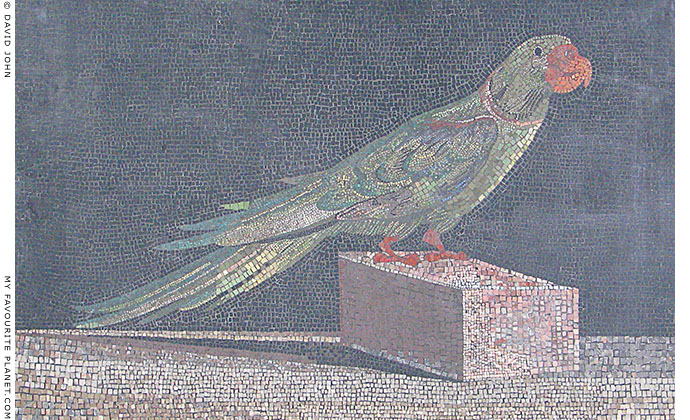
Hellenistic mosaic of an Alexandrine parakeet from Pergamon,
now in the Pergamon Museum, Berlin. |
| |
The species Alexandrine parakeet or Alexandrian parrot (scientific name Psittacula eupatria, noble fatherland or of noble ancestry) is named after Alexander the Great, who is said to have first sent several of the birds from the Punjab to the west, where they became popular as exotic pets of rich and noble families.
The Hellenistic mosaic floor panel, made in Pergamon around the middle of the 2nd century BC (the time of Eumenes II and Attalus II) of natural stone, was part of a large mosaic floor, discovered by a team of archaeological excavators led by Richard Bohn on 23 June 1886, in the small "Altar Room" of Palace V of the Pergamon Acropolis. [1]
It is thought that Palace V, just to the north of the Temple of Trajan (see the model of the Pergamon Acropolis on gallery 1, page 4), was the king's official building, and the neighbouring Palace IV was the royal private residence.
The type of mosaic found in some of Pergamon's ancient buildings is known as opus vermiculatum (Latin, worm-like work), a technique invented in Greece, in which images are made of rows of coloured tesserae (small cube-shaped pieces of stone, and later also of glass). The subtle colouring of the mosaics imitated painting. Individual motifs, including mythical figures, animals and plants were surrounded by dark tesserae, which highlight the vibrant colours. Often, outlines marked by rows of tessarae were used as contours or to further heighten the pictorial effect, as in drawing. This mosaic artist has used only colour and tone for his subject in a painterly manner, resembling trompe l'oeil realism.
Such panels were known as emblemata, often made separately in the artist's workshop before being transported to the site and cemented into place with mortar. This method had the advantage of allowing the artist to prepare small, easily transportable areas of a floor in advance and leave the work of fixing and finishing to assistants.
Some mosaic artists signed their work. The earliest known signature is on the Stag Hunt mosaic floor in the House of the Abduction of Helen, Pella, Greece, signed "ΓΝΩΣΕΙΣ ΕΠΟΗΣΕΝ" (Gnoseis epoesen, Gnoseis created this).
A fragment of the central panel of a floor mosaic, also from Pergamon Palace V, has a picture of a piece of parchment held down with drops of wax at the corners, with one corner curled up, bearing the signature of Hephaistion. Unfortunately, the rest of the image was destroyed, but the signature and the remains of the decorative mosaic border can be seen in the Pergamon Museum, Berlin. |
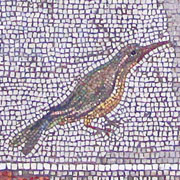
Bird from a panel of the same mosaic floor as the parakeet.
See photo below.
Pergamon Museum, Berlin. |
| |
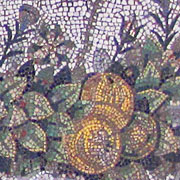
Fruit and foliage from the same mosaic panel. |
| |
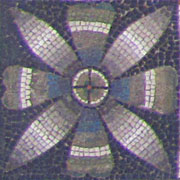
Floral corner emblem of the border of the mosaic floor. |
| |
| |
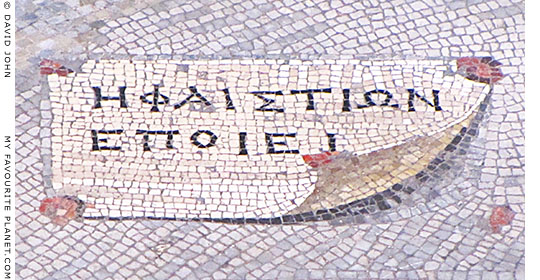
Hephaistion's signature "ΗΦΑΙΣΤΙΩΝ ΕΠΟΙΕΙ" (Hephaistion epoiei, Hephaistion made it)
on the 2nd century BC floor mosaic from the "Northwest Room" of Pergamon Palace V.
Now in the Pergamon Museum, Berlin (see photo below).
Height of lettering 11 cm, height of cartellino 20cm.
|
However, we know almost nothing about these artists. The only surviving reference to a mosaic artist in ancient literature is by Pliny the Elder (23-79 AD), who mentions an artist named Sosos who worked at Pergamon:
"Pavements are an invention of the Greeks, who also practised the art of painting them, till they were superseded by mosaics. In this last branch of art, the highest excellence has been attained by Sosus, who laid, at Pergamus, the mosaic pavement known as the 'asarotos oecos': from the fact that he there represented, in small squares of different colours, the remnants of a banquet lying upon the pavement, and other things which are usually swept away with the broom, they having all the appearance of being left there by accident.
There is a dove also, greatly admired, in the act of drinking, and throwing the shadow of its head upon the water; while other birds are to be seen sunning and pluming themselves, on the margin of a drinking bowl." [2]
Although none of the works of Sosos have yet been identified, Roman imitations of his "asarotos oikos" (unswept house; literally, The house that has no sweeping), usually known as "the unswept room", still exist. |
|
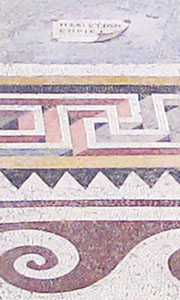
Hephaistion's signature on
the floor mosaic of Palace V. |
|
| |
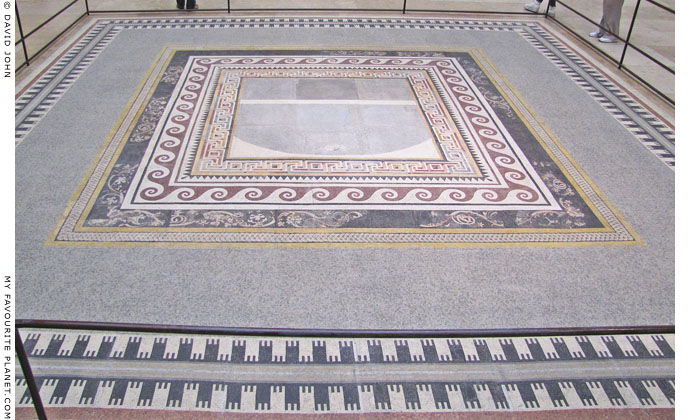
The reconstructed floor mosaic from the "Northwest Room"
of Pergamon Palace V in the Pergamon Museum, Berlin. |
| |
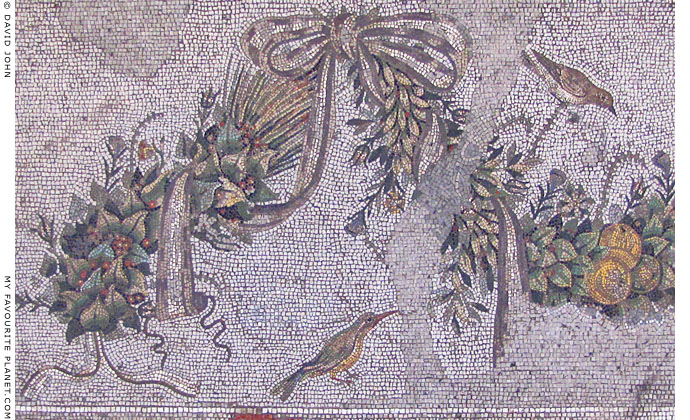
Part of one of the reconstructed lower bands of the same mosaic floor as the Alexandrine parakeet,
from the "Altar Room" of Pergamon Palace V. Pergamon Museum, Berlin. |
| |
More photos and information about mosaics
on My Favourite Planet:
Mosaic artists
Short articles about ancient Greek mosaic artists
in the MFP People section.
Hellenistic mosaics in Pella, Macedonia, Greece.
A mosaic of Dionysos and "Sleeping Ariadne" from Ephesus,
now in the Izmir Archaeological Museum, Turkey:
Selcuk photo gallery 2
The "Alexander Mosaic" from Pompeii, depicting
Alexander the Great in battle with King Darius III:
Alexander the Great
in the MFP People section
Ancient mosaics depicting the Gorgon Medusa
Mosaics from Pompeii signed by Dioskourides of Samos
Mosaics at Dion Archaeological Site, Macedonia, Greece:
Dion: garden of the Gods
at the Cheshire Cat Blog
"Choklakia" mosaics in Kastellorizo, Greece:
Kastellorizo photo gallery
Mosaics of Saint John the Theologian, on Patmos, Greece:
Patmos photo gallery
Modern mosaic commemorating Saint Paul
the Apostle's visit to Veria, Macedonia, Greece:
Veria photo gallery
See also a mosaic mural made by the author of this guide:
davidjohnberlin.de |
| |
Pergamon
gallery 2 |
Notes, references and links |
 |
|

Floor plan of the "Altar Room" (about 3 metres square) on the east
side of Palace V on the Pergamon Acropolis, showing the location
in which the mosaic of the Alexandrine parakeet was found. [1] |
| |
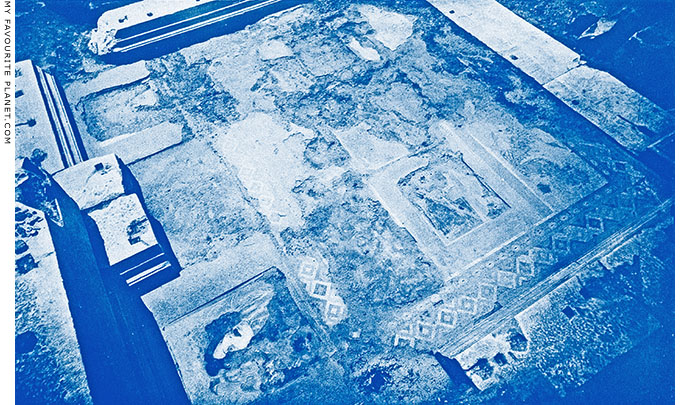
Photo of the mosaic floor of the "Altar Room" in Palace V, taken by Herr Senz,
shortly after it had been unearthed during the archaeological excavation in June 1886. [1] |
| |
1. Palace V of the Pergamon Acropolis
The "Altar Room" is also referred to as the "Banqueting Room" (exhibition material for "Pergamon. Panorama der antiken Metropole", Pergamon Museum, Berlin, 2012.)
For a description and report of the discovery and excavation of the mosaic floor by the Berlin-born archaeological architect Richard Bohn (1849-1898), see:
Georg Kawerau and Theodor Wiegand, Altertümer von Pergamon, Band V 1: Die Paläste der Hochburg. Baugruppe V, pages 30-39 and 58-63, and numerous photographic plates. Staatliche Museen zu Berlin.
Druck und Verlag von Walter de Gruyter & Co., Berlin und Leipzig, 1930.
Sources of images above:
Floor plan of the "Altar Room", fig. 39, page 32.
Photo of the mosaic floor of the "Altar Room" by Herr Senz, plate XXVI.
The photographs taken during the excavations were stored in the archive of the Pergamon Museum, Berlin. Many were described in the book as being "no longer suitable for reproduction", presumably meaning that by 1930 they had already degenerated.
2. Pliny the Elder on mosaics
Pliny the Elder, The Natural History, Book 36, chapter 60. At Perseus Digital Library.
See also:
K. M. D. Dunbabin, Mosaics of the Greek and Roman world. Cambridge University Press, 1999.
Pollitt, Jerome Jordan, The art of ancient Greece: sources and documents. Cambridge University Press, 1990. At Google Books. |
|
|
| |

A geometric border panel of the mosaic floor from the "Altar Room" of Pergamon Palace V.
Pergamon Museum, Berlin. |
Maps, photos and articles: © David John,
except where otherwise specified.
Additional photos: © Konstanze Gundudis
All photos and articles are copyright protected.
Images and materials by other authors
have been attributed where applicable.
Please do not use these photos or articles without permission.
If you are interested in using any of the photos for your website,
project or publication, please get in contact.
Higher resolution versions are available on request. |
| |
 |
Visit the My Favourite Planet Group on Facebook.
Join the group, write a message or comment,
post photos and videos, start a discussion... |
|
|
| |
|
|
|